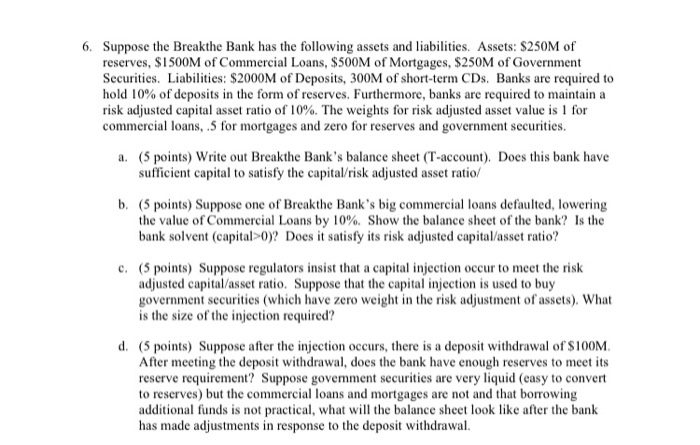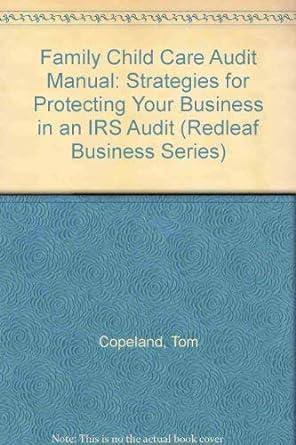i need help with this question

6. Suppose the Breakthe Bank has the following assets and liabilities. Assets: $250M of reserves, $1500M of Commercial Loans, $500M of Mortgages, $250M of Government Securities. Liabilities: $2000M of Deposits, 300M of short-term CDs. Banks are required to hold 10% of deposits in the form of reserves. Furthermore, banks are required to maintain a risk adjusted capital asset ratio of 10%. The weights for risk adjusted asset value is 1 for commercial loans, .5 for mortgages and zero for reserves and government securities. a. (5 points) Write out Breakthe Bank's balance sheet (T-account). Does this bank have sufficient capital to satisfy the capital/risk adjusted asset ratio/ b. (5 points) Suppose one of Breakthe Bank's big commercial loans defaulted, lowering the value of Commercial Loans by 10%. Show the balance sheet of the bank? Is the bank solvent (capital>0)? Does it satisfy its risk adjusted capital/asset ratio? c. (5 points) Suppose regulators insist that a capital injection occur to meet the risk adjusted capital/asset ratio. Suppose that the capital injection is used to buy government securities (which have zero weight in the risk adjustment of assets). What is the size of the injection required? d. (5 points) Suppose after the injection occurs, there is a deposit withdrawal of S100M After meeting the deposit withdrawal, does the bank have enough reserves to meet its reserve requirement? Suppose goverment securities are very liquid (easy to convert to reserves) but the commercial loans and mortgages are not and that borrowing additional funds is not practical, what will the balance sheet look like after the bank has made adjustments in response to the deposit withdrawal. 6. Suppose the Breakthe Bank has the following assets and liabilities. Assets: $250M of reserves, $1500M of Commercial Loans, $500M of Mortgages, $250M of Government Securities. Liabilities: $2000M of Deposits, 300M of short-term CDs. Banks are required to hold 10% of deposits in the form of reserves. Furthermore, banks are required to maintain a risk adjusted capital asset ratio of 10%. The weights for risk adjusted asset value is 1 for commercial loans, .5 for mortgages and zero for reserves and government securities. a. (5 points) Write out Breakthe Bank's balance sheet (T-account). Does this bank have sufficient capital to satisfy the capital/risk adjusted asset ratio/ b. (5 points) Suppose one of Breakthe Bank's big commercial loans defaulted, lowering the value of Commercial Loans by 10%. Show the balance sheet of the bank? Is the bank solvent (capital>0)? Does it satisfy its risk adjusted capital/asset ratio? c. (5 points) Suppose regulators insist that a capital injection occur to meet the risk adjusted capital/asset ratio. Suppose that the capital injection is used to buy government securities (which have zero weight in the risk adjustment of assets). What is the size of the injection required? d. (5 points) Suppose after the injection occurs, there is a deposit withdrawal of S100M After meeting the deposit withdrawal, does the bank have enough reserves to meet its reserve requirement? Suppose goverment securities are very liquid (easy to convert to reserves) but the commercial loans and mortgages are not and that borrowing additional funds is not practical, what will the balance sheet look like after the bank has made adjustments in response to the deposit withdrawal








